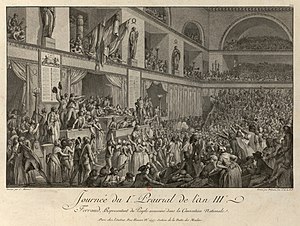
The following is a timeline of the French Revolution.

The National Convention was the constituent assembly of the Kingdom of France for one day and the French First Republic for its first three years during the French Revolution, following the two-year National Constituent Assembly and the one-year Legislative Assembly. Created after the great insurrection of 10 August 1792, it was the first French government organized as a republic, abandoning the monarchy altogether. The Convention sat as a single-chamber assembly from 20 September 1792 to 26 October 1795.

The sans-culottes were the common people of the lower classes in late 18th-century France, a great many of whom became radical and militant partisans of the French Revolution in response to their poor quality of life under the Ancien Régime. The word sans-culotte, which is opposed to "aristocrat", seems to have been used for the first time on 28 February 1791 by Jean-Bernard Gauthier de Murnan in a derogatory sense, speaking about a "sans-culottes army". The word came into vogue during the demonstration of 20 June 1792.

François-Antoine, Count of the Empire (1756–1826) was a French writer, lawyer and politician during the Revolution and the Empire.
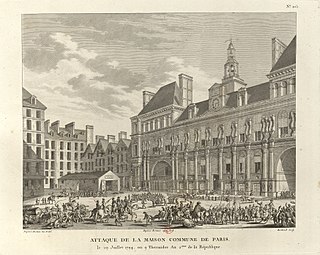
The Paris Commune during the French Revolution was the government of Paris from 1789 until 1795. Established in the Hôtel de Ville just after the storming of the Bastille, it consisted of 144 delegates elected by the 60 divisions of the city. Before its formal establishment, there had been much popular discontent on the streets of Paris over who represented the true Commune, and who had the right to rule the Parisian people. The first mayor was Jean Sylvain Bailly, a relatively moderate Feuillant who supported constitutional monarchy. He was succeeded in November 1791 by Pétion de Villeneuve after Bailly's unpopular use of the National Guard to disperse a riotous assembly in the Champ de Mars.
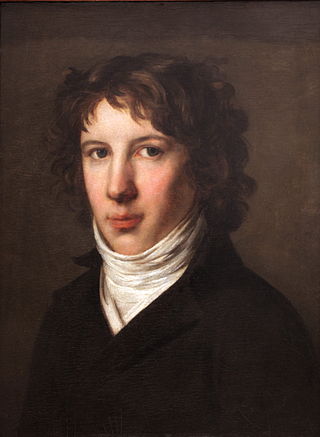
Louis Antoine Léon de Saint-Just, sometimes nicknamed the Archangel of Terror, was a French revolutionary, political philosopher, member and president of the French National Convention, a Jacobin club leader, and a major figure of the French Revolution. He was a close friend of Maximilien Robespierre and served as his most trusted ally during the period of Jacobin rule (1793–94) in the French First Republic. Saint-Just worked as a legislator and a military commissar, but he achieved a lasting reputation as the face of the Reign of Terror. He publicly delivered the condemnatory reports that emanated from the Committee of Public Safety and defended the use of violence against opponents of the government. He contributed to the arrests of some of the most famous figures of the Revolution, many of whom ended up at the guillotine.

The insurrection of 10 August 1792 was a defining event of the French Revolution, when armed revolutionaries in Paris, increasingly in conflict with the French monarchy, stormed the Tuileries Palace. The conflict led France to abolish the monarchy and establish a republic.
The Enragés, commonly known as the Ultra-radicals, were a small number of firebrands known for defending the lower class and expressing the demands of the radical sans-culottes during the French Revolution. They played an active role in the 31 May – 2 June 1793 Paris uprisings that forced the expulsion of the Girondins from the National Convention, allowing the Montagnards to assume full control. The Enragés gained their name for their angry rhetoric appealing to the National Convention to take more measures that would benefit the poor. Jacques Roux, Jean-François Varlet, Jean Théophile Victor Leclerc and Claire Lacombe, the primary leaders of the Enragés, were strident critics of the National Convention for failing to carry out the promises of the French Revolution.
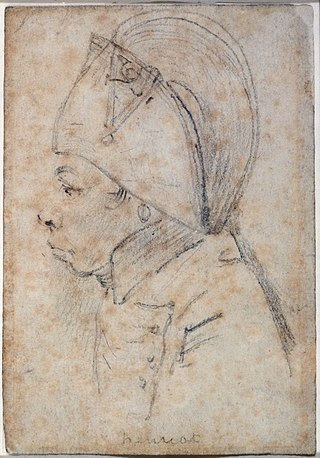
François Hanriot was a French Sans-culotte leader, street orator, and commander of the Garde Nationale during the French Revolution. He played a vital role in the Insurrection of 31 May – 2 June 1793 and subsequently the fall of the Girondins. On 27 July 1794 he tried to release Maximilien Robespierre, who was arrested by the Convention. He was executed on the next day – together with Robespierre, Saint-Just and Couthon – by the rules of the law of 22 Prairial, only verifying his identity at the trial.
The Hébertists, or Exaggerators were a radical revolutionary political group associated with the populist journalist Jacques Hébert, a member of the Cordeliers club. They came to power during the Reign of Terror and played a significant role in the French Revolution.

The White Terror was a period during the French Revolution in 1795 when a wave of violent attacks swept across much of France. The victims of this violence were people identified as being associated with the Reign of Terror – followers of Robespierre and Marat, and members of local Jacobin clubs. The violence was perpetrated primarily by those whose relatives or associates had been victims of the Great Terror, or whose lives and livelihoods had been threatened by the government and its supporters before the Thermidorean Reaction. Principally, these were, in Paris, the Muscadins, and in the countryside, monarchists, supporters of the Girondins, those who opposed the Civil Constitution of the Clergy and those otherwise hostile to the Jacobin political agenda.
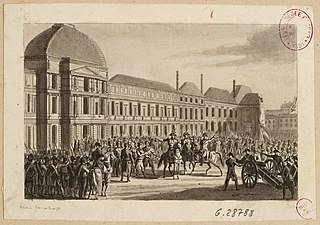
The insurrection of 31 May – 2 June 1793, during the French Revolution, started after the Paris commune demanded that 22 Girondin deputies and members of the Commission of Twelve should be brought before the Revolutionary Tribunal. Jean-Paul Marat led the attack on the representatives in the National Convention, who in January had voted against the execution of the King and since then had paralyzed the Convention. It ended after thousands of armed citizens surrounded the Convention to force it to deliver the deputies denounced by the Commune.The insurrection resulted in the fall of 29 Girondins and two ministers under pressure of the sans-culottes, Jacobins, and Montagnards.
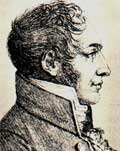
Jacques-Alexis Thuriot, known as Thuriot de la Rosière, and later as chevalier Thuriot de la Rosière, chevalier de l'Empire was an important French statesman of the French Revolution, and a minor figure under the French Empire of Napoleon Bonaparte.

The insurrection of 12 Germinal Year III was a popular revolt in Paris on 1 April 1795 against the policies of the Thermidorian Convention. It was provoked by poverty and hunger resulting from the abandonment of the controlled economy after dismantling of the Revolutionary Government during Thermidorian Reaction.

Pierre Joseph Duhem was a French physician and politician.

The Demonstration of 20 June 1792 was the last peaceful attempt made by the people of Paris to persuade King Louis XVI of France to abandon his current policy and attempt to follow what they believed to be a more empathetic approach to governing. The demonstration occurred during the French Revolution. Its objectives were to convince the government to enforce the Legislative Assembly's rulings, defend France against foreign invasion, and preserve the spirit of the French Constitution of 1791. The demonstrators hoped that the king would withdraw his veto and recall the Girondin ministers.

Paris in the 18th century was the second-largest city in Europe, after London, with a population of about 600,000 people. The century saw the construction of Place Vendôme, the Place de la Concorde, the Champs-Élysées, the church of Les Invalides, and the Panthéon, and the founding of the Louvre Museum. Paris witnessed the end of the reign of Louis XIV, was the center stage of the Enlightenment and the French Revolution, saw the first manned flight, and was the birthplace of high fashion and the modern restaurant and bistro.
Jacques Garnier, also called Garnier de Saintes, was born in Saintes on 30 March 1755, and drowned in the Ohio river in 1817 or 1818 was a French politician, a lawyer and a revolutionary.
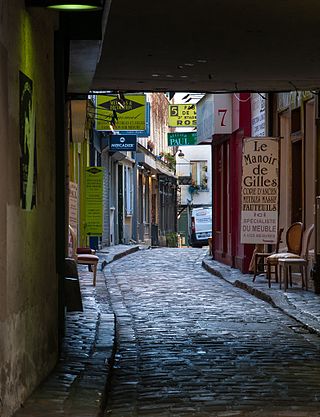
The Faubourg Saint-Antoine was one of the traditional suburbs of Paris, France. It grew up to the east of the Bastille around the abbey of Saint-Antoine-des-Champs, and ran along the Rue du Faubourg Saint-Antoine.

The Coup d'état of 9 Thermidor or the Fall of Maximilien Robespierre is the series of events beginning with Maximilien Robespierre's address to the National Convention on 8 Thermidor Year II, his arrest the next day, and his execution on 10 Thermidor. In the speech of 8 Thermidor, Robespierre spoke of the existence of internal enemies, conspirators, and calumniators, within the Convention and the governing Committees. He refused to name them, which alarmed the deputies who feared Robespierre was preparing another purge of the Convention.
